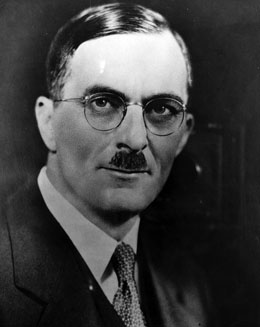On March 3, 1933, Washington Governor Clarence Martin (1887-1955) closes all banks in Washington state for a "bank holiday" after the banking system collapses. The banks will remain closed, or open under great restrictions, until March 13, 1933.
Abnormal Conditions
On the evening of Thursday, March 2, 1933, the Governor issues a proclamation closing the banks which begins "Whereas abnormal economic conditions prevail" (Seattle Post-Intelligencer March 3, 1933). These "abnormal economic conditions" are caused by the Depression and by failed bank loans which forced some banks to go bankrupt with depositors losing their money.
Loss of Confidence
In a run on banks, customers closed their accounts and completely withdrew their funds. All U.S. currency is backed by gold, and across the country hundreds of thousands of people demanded their withdrawal in gold. Banks throughout the United States, including those in King County, are unable to meet the demand.
On March 2, 1933, Washington State Senate Bill No. 185 was introduced authorizing the governor to declare a bank holiday to force the temporary closure of all banks in the state. By the end of the day the bill passed both houses and was sent to Governor Clarence Martin. Governor Martin signed it and immediately declared a three day statewide "bank holiday" for Friday, Saturday, and Monday March 3-6, 1933. By Saturday March 4, each of the 48 states of the union declared a statewide "bank holiday."
They Lock Their Doors
All banks locked their doors, and customers could not even get access to their safe deposit boxes. In King County, checks replaced cash for most transactions. Most of the larger retail establishments accepted most payroll checks and checks from known companies as payment for purchases. They gave change by writing store checks. Many small stores operated on a cash only basis. The only place that would cash checks was the Post Office, but only for federal paychecks and checks drawn from the U.S. Treasury.
The Clearing House Association, an association of nearly all banks in the city, was located at the Alaska Building (southeast corner 2nd Avenue and Cherry Street) in Downtown Seattle. The association's main function was to process and route checks and money between banks. Clearing houses similar to Seattle's were located in larger cities throughout the country.
In response to this crisis, most Clearing Houses decided to issue "certificates" which would temporarily replace U.S. currency. In Seattle, the Clearing House immediately started printing 2,275,000 certificates in denominations of $20 (printed in orange), $10 (printed in brown), $5 (printed in green), and $1 (printed in blue). By Monday, March 6, 2,275,000 certificates were printed totaling $15,000,000 and are distributed to local banks. These certificates were printed but never issued.
On March 5, 1933, President Franklin D. Roosevelt (1882-1945) declared a national "bank holiday" until March 9, which is subsequently extended through Monday, March 13. The Roosevelt administration decided that the federal government could issue U.S. currency not backed by gold and start printing Federal Reserve Bank notes. Until the bank notes were distributed, banks were allowed to open on a limited basis. On Monday March 6, King County banks opened and allowed access to safety deposit boxes, allowed stores to exchange currency for change, and allowed customers to make deposits. On Wednesday, six days after banks locked their doors, customers were allowed to cash personal or payroll checks but only if there was an urgent need and then they could not exceed $25.
Not Fun
On Tuesday March 14, the 11-day "bank holiday" ended. Seattle, Tacoma, and Spokane banks opened for regular business except that they could not redeem gold certificate currency for gold. Banks in the rest of the state, including rural King County, opened the next day.

